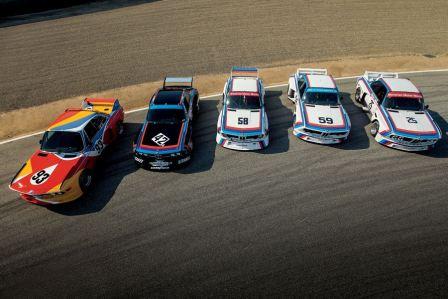

| site search byfreefind | |||
|
|||
BMW 30 CSL IMSA
Summay:
2275985,
2275986, 2275987,
2275988
and 2275992 were all built for BMW`s
1975 IMSA program & 1976 IMSA Camel GT
Series in Group 4 specifications.
2275988
came back to Europe in June 1975. End of
1975 2275985
and 2275986
were left with Gregg for his use in `76,
and 2275987
returned to Europe. Both 2275987
&
2275988
were converted by the factory into Group
5 cars winter `75-6 (2275988 Faltz
& 2275987` Hermetite...) and both raced around
the World during 1976 so not possible
Gregg had either. All five
chassis are still in existence.
Details:
2275984 was built to IMSA specification late in the 1975 season, but it was built as a show car rather than an active race car. That means the IMSA cars raced by BMW NA bore serial numbers
2275985,
2275986, 2275987,
2275988 and 2275992. The last of those, 2275992, was originally built for racing in Europe and then converted to IMSA Group 4 specification; more on this later.
On the occasion of the BMW 100th Anniversary celebrations in Monterey this past August, BMW NA was able to assemble all five cars at the Rolex Monterey Motorsports Reunion—likely the only time they have ever been together in one place. We were also able to have on hand a very proud Rudi Gmeiner, electrical technician Peter Heiss and designer/fabricator Art Simonds for the occasion. The 2002 Bimmer article implied that all but one of the five cars were shipped to the U.S. at the beginning of the 1975 season; it then attempted to chronicle each car’s racing history through 1975 and beyond. On the contrary, Gmeiner
said he was quite sure that the team started with two cars
initially and that the other chassis were substituted in
over the season. From this assertion, it was believed that
the first two cars—the ones that would have raced at the
season opener in Daytona and then given BMW its big victory
at Sebring—would be those with the lowest chassis numbers,
namely
2275984 and
2275985.
However, some documentation suggested that highest chassis
numbers in the range—2275987 and
2275988—were the Daytona and Sebring cars. Why would the first and therefore the oldest chassis have the latest/highest serial numbers? It would be much more plausible for the lowest chassis numbers to be the first cars.
To add to the confusion, the Cowboys typically didn’t use the chassis numbers for identifying the cars in their race reports but rather by a Build Code like “E9-R2-13,” for example, where E9 was the model code, R2 was the revision number and 13 was the car number in ascending order (i.e. a higher number meant a later car). Not even the Cowboys could rationalize the conflicting information…until recently. Gmeiner and the other Cowboys worked hard to solve the puzzle. Eventually, Gmeiner was able to produce a hand written document labeled Kommisionbuch (which roughly translates to “build book”) that listed all the racing CSLs built and who had built them. Interestingly, this document was referenced in the original article, but its significance was not fully understood. This document provided the solution to the chassis chronology and cross-referenced the chassis numbers with the Build Codes. It is, in effect, the Rosetta Stone that unlocks the mystery of the racing CSLs.
As one would expect of a logical German company, BMW Motorsport decided that the homologation group of street CSLs
would start at serial number 2 275 001 and go upward from
there. Then, in order to keep the race car chassis number
range separate, BMW Motorsport decided to start the race car
serial numbers at
2276000 and progress downward. It was, dare I say, un-Germanic logic, in which the lower the serial number, the later the car was built. To confuse matters further, the Build Codes were issued in ascending order, with later cars having higher numbers.
With this crucial piece of information in hand, many mysteries could finally be unraveled, and the provenance of each IMSA CSL
could be established with reasonable certainty.
Agenda of races:
- Daytona
- 24h Sebring
- Road Atlanta
- Laguna Seca
- Riverside
- Lime Rock
- Mid-Ohio
- Mosport
- Daytona 250
- Mid-America
- Talladega
- Mid-Ohio 6h
- Daytona Finale
Thank you / Reference / Credit:


